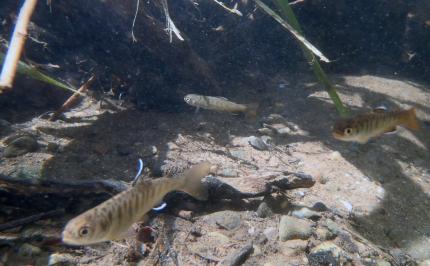The Family Forest Fish Passage Program is a grant program that helps small forest landowners improve fish passage on their land as required by the 1999 Forests and Fish law. The program provides funding to replace or remove culverts on private forest lands that block salmon and trout from migrating upstream.
Eligibility requirements
- Forest landowner harvests less than two million board feet of timber per year.
- Stream crossing provides road access to harvestable trees.
- Parcel is at least two acres.
- Stream is potentially fish bearing. A stream may be fish bearing if it is wider than two feet in Western Washington or three feet in Eastern Washington, and has a gradient of less than 20%.
Applying to this program relieves forest landowners of the Washington State Forest Practices (Title 222 WAC) obligation to remove fish barriers.

Benefits for fish and landowners

Removing fish barriers helps increase salmon and trout populations. Reconnecting spawning and rearing habitat allows fish to move freely throughout a stream. Adult salmon migrate upstream to suitable spawning gravels, dig a nest (known as a redd), and lay thousands of eggs. Once the eggs hatch, juvenile salmon (known as fry) move upstream or downstream in search of suitable rearing habitat. Pools, beaver ponds, and wetlands provide excellent rearing habitat with slow moving water and a feast of aquatic insects to eat.
Adult salmon have excellent jumping abilities and may be able to jump some fish passage barriers. Juvenile fish and other fish species like mudminnows are not strong jumpers and must be considered when evaluating a fish passage barrier. The Family Forest Fish Passage Program typically replaces barrier culverts with bridges, which are the best option for all species and life stages of fish. Bridges can also help mammals, amphibians, and reptiles safely cross roads.
Installing a larger culvert or bridge that passes high stream flows benefits landowners by reducing maintenance costs, road erosion, and flooding. When stream waters are high, undersized culverts can get blocked by debris and fail. Flood waters flowing over a roadway or eroding the roadway bed also create safety hazards. Installing a larger culvert or bridge that passes high stream flows reduces future maintenance costs. Landowners also benefit by having more salmon and trout in their stream.
How to apply
The Washington Department of Natural Resources manages the Family Forest Fish Passage Program and accepts applications year round. If your project meets the eligibility requirements, a WDFW biologist will conduct a site visit to confirm your culvert is a barrier.